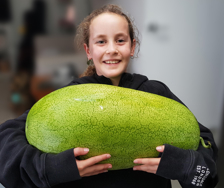The weather is supposed to take a turn for the worse this weekend – not only a lot of rain, but wind and cold temperatures. I don’t think many of us will be spared – or the forecasters could have it wrong, but it is always good to err on the side of caution.
Now is a good time to look at feeding the garden. If you have prepared the soil well, it should have active micro communities of beneficial insects, worms, bacteria, and fungi working hard at processing the organic and inorganic components of the soil and reducing it to a molecular form that the plants can absorb.
The way plants take on nutrients is through their roots – if you think of it like a sort of conveyor belt system going from outside the roots, into the plant and right up into the leaves. This conveyor system is essentially water, and it travels right through the plant and evaporates out the leaves in a continuous ‘conveyor.’ This is why it is really important to keep plants well-watered. If they lose access to moisture, the conveyor stops and the whole internal workings of the plant are brought to a standstill.
The water can flow freely in and out of the roots through osmosis depending on chemical concentrations – if you can remember that from school. As the nutrients enter the root, they have to pass though entrances that are specifically designed to recognise various nutrient molecules. The access points also represent the quantities of each nutrient that can gain access.
It’s not very scientific but I like to think of the space outside the root as a wet place where chemicals are milling about – some sloshing in water and others clinging to soil particles and the conveyor is like a rollercoaster and each seat is specifically saved for the required nutrients who jump in when they see their spot. If it dries out the rollercoaster stops running. It is important to ensure there are enough nutrients to fill all the seats. But not too many as this can cause problems that can be difficult to fix.
Plants only need 16 nutrients: The top three are Nitrogen, Potassium and Phosphorus – the trio of NPK. The secondary elements are Calcium (Ca), Magnesium (Mg) and Sulphur (S). The plants don’t need a lot of these. Then there are the micronutrients: Boron (B), Chlorine (Cl), Copper (Cu), Iron (Fe), Manganese (Mn), Molybdenum (Mo), and Zinc (Zn) and the plant only need a trace amount of these and too much would be a bad thing.
To complete the 16 are Carbon (C), Hydrogen (H) and Oxygen (O) which the plants get from air and water.
So as far as plants are concerned it doesn’t matter where the nutrients come from so long as they are small enough to be absorbed. So, a quick pick me up with a liquid feed will get straight to plant if they look a little peaky. But for the most part a soil with plenty of organic material and slow-release fertilisers like blood and bone or a general purpose fertiliser, will keep the soil organisms happy producing a constant feed for your plants. The key is not to overwhelm anybody. There is such a thing too much of a good thing.
I hope all of this makes sense. Often once you understand the ‘why’ it makes the ‘doing’ easier. Sometimes feeding plants feels like chucking things at them and hoping for the best!
In my garden I’m still trying to chip away at all the small and large tasks to create a sense of order in the garden. I’ve done a lot of work on my strawberries this week building a net over them. They had taken quite a hit from having their berries and leaves attacked, so hopefully the net will give them a break to recover themselves. I’m using Yates Thrive Strawberry & Berry Fruit Liquid Plant Food with some Seaweed Tonic so I can be sure they are getting what they need to thrive!
Happy gardening and as always – if you want to get in touch leave a comment below.
Sarah the Gardener : o)
Image: Some of my weedy mess… I had trouble deciding which bit to show you. There are so many options! This is probably one of the worst areas as it was once a well-maintained spot but as it is in the Friday Sector of my garden care routine …. it slipped a little…










Share
Share this blog on social media